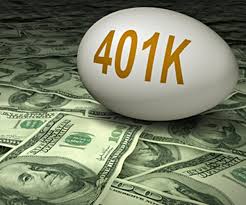Making The Best Use Of Your 401(K) Plan

A 401(k) plan is a tax-advantaged and defined-contribution retirement account offered to
employees by their employers. The 401(k) plan has a section in the United
States Internal Revenue Code. Employees make contributions to their 401(k)
accounts via an automatic payroll withholding, and then the employers can match
some or all of the contributions
made by the employees.
Two types of 401(k) accounts exist. These are
traditional 401(k)s and Roth 401(k)s. The two types of 401(k) accounts are
similar in many aspects, however, differ in the way they are taxed. Employees
can operate either or both types of account.
The
investment earnings in a traditional 401(k) plan are usually not taxed until
the employee withdraws that money, often after retirement. Withdrawals could be
tax-free in a Roth 401(k) plan.
In a
401(k) plan also known as a defined
contribution plan, the employee
and employer usually make contributions to the account, up to the dollar limits
set by the Internal Revenue Service. Recently, 401(k) plans have become very
familiar and useful, while traditional pensions have become increasingly rare,
as employers have shifted the responsibility and risk of saving for retirement
to their employees. Traditional
pensions are referred to as defined benefits plans and the employer is responsible for
providing a specific amount of money to the employee upon retirement.
Employees are solely responsible for choosing
the specific investments within their 401(k) accounts, from the selection their
employer offers. The offerings include an assortment of stock, bonds, mutual
funds and target-date funds
that hold a mixture of stocks and
bonds appropriate in terms of risk for when that person expects to retire. They
may also include guaranteed investment contract issued by insurance companies or stocks owned by the employer.
The highest amount that can be contributed by
an employee or employer to a 401(k) plan is often adjusted routinely to account
for inflation. According to the Internal Revenue Service: As of 2019, the basic
limits on employee contributions are $19,000 per year for workers under age 50
and $25,000 for those 50 and up (including the $6,000 catch-up contribution).
If the employer also contributes (or if the employee elects to make additional,
non-deductible 'after tax contributions' to their traditional 401(k) account),
the total employee/employer contribution for workers under 50 is capped at
$56,000, or 100% of employee compensation, whichever is lower. For those 50 and
over, the limit is $62,000. The report predicts that in 2020, all those figures
go up. Basic contributions rise to $19,500 and the catch-up to $6,500. The cap,
including employer contributions, becomes $57,000—$63,500 for those 50 and
older.
Employers who match their employee contributions
use different formulas to calculate that match. Financial advisors often
recommend that employees try to contribute at least enough money to their
401(k) plans each to get the full employer match.
Employees can organize their account in such a
way that if an employer offers both choices, they can split their
contributions, putting some money into a traditional 401(k) and some into a
Roth 401(k). Though, the total contribution to the two types of accounts cannot
exceed the limit for one account (such as $19,500 in 2020). Employer
contributions can only go into a traditional 401(k) account, where they will be
subject to tax upon withdrawal.


Be the first to comment!
You must login to comment